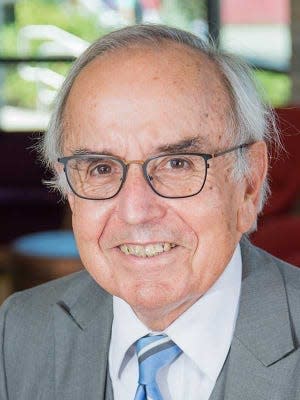Arthur Cyr: Neglected lessons of the Cuban Missile Crisis
- Oops!Something went wrong.Please try again later.
- Oops!Something went wrong.Please try again later.
- Oops!Something went wrong.Please try again later.
Last week was the anniversary of the most dangerous confrontation in history, yet the media and public paid little heed. During Oct. 22-28, 1962, Washington and Moscow sparred on the edge of thermonuclear war.
Lessons remain of fundamental importance. They include difficulty of securing accurate intelligence, and the unpredictability of events.
On Oct. 14, 1962, U.S. reconnaissance photos revealed the Soviet Union placing offensive nuclear missiles in Cuba, despite contrary assurances. After the developed film was thoroughly reviewed, National Security Adviser McGeorge Bundy informed President John F. Kennedy

Senior Kennedy administration officials, with the exception of CIA director John McCone, assumed Moscow would never put long-range missiles into Cuba. U.S. actions against Cuba’s communist regime, including secret efforts to kill leader Fidel Castro, alarmed Soviet leader Nikita Khrushchev.
Earlier the White House curtailed Cuba reconnaissance flights, resuming only because McCone insisted. Photographic evidence of the missiles arrived just before they would become operational.
However, there were already indicators, including from reliable Cuba agents, that something of this nature was underway. Senior officials convinced themselves otherwise.
Kennedy and advisers spent a week debating options. At the start of the crisis, there was strong sentiment, especially among the Joint Chiefs of Staff, for a conventional air attack followed by invasion of Cuba.
JFK imaginatively decided instead on a naval “quarantine” as the U.S. first step. His televised speech on October 22 demanded removal of the missiles and announced initial moves, reflecting careful, thoughtful planning. Until the Kremlin agreed to withdraw the missiles, Armageddon loomed.
Years after the crisis, decision-makers from Cuba, the Soviet Union and the United States initiated a series of meetings, which have revealed important new information. Soviet commanders in Cuba already had shorter-range nuclear-armed missiles, and for a time independent authority from Khrushchev to use them if U.S. military forces invaded.
Soviet submarines had nuclear-armed torpedoes. The torpedo would vaporize the launching vessel, which discouraged American interest in this extreme weapon.
Soviet naval officer Vasili Arkhipov refused to concur with submarine commander Valentine Savitsky, who had decided to launch the nuclear torpedo. U.S. surface ships and aircraft relentlessly harassed the sub, which surfaced.
Commander William Morgan, captain of the USS Cory, became Arkhipov’s ally. After communicating an apology for aggressive American actions, he told his signalman, “Keep that Russian bastard happy.”
Bundy’s 1988 book “Danger and Survival — Choices About the Bomb in the First Fifty Years,” revealed JFK privately accepted the Soviet proposed Cuba-Turkey missile trade.
Throughout the crisis, Kennedy demonstrated calm open-minded engagement. His assembled advisers debated a wide range of options. As tensions mounted, the president defused the atmosphere.
Initial pressure for military attack dissipated. Kennedy deftly delayed decision for war, while keeping discussion going and playing for time.
Afterwards. direct communication between Moscow and Washington was established. The Partial Nuclear Test Ban Treaty of 1963, overwhelmingly approved by the U.S. Senate, ended nuclear testing in the atmosphere.
Further lessons of the crisis include the importance of an open mind, communication with opponents, and calm and responsible leadership.
Russia and Ukraine, Israel and terrorist army Hamas are at war and our troops are in the Middle East and elsewhere. Israel and Russia possess nuclear weapons. Yet Americans generally put domestic over international concerns. This parochialism is perilous.
After atomic bombs were dropped on Hiroshima and Nagasaki, President Harry Truman ordered that only the president could authorize the use of the horrific weapon.
— Arthur I. Cyr published an article on the Cuban Missile Crisis in the autumn 2022 “Parameters,” the U.S. Army War College journal. Contact acyr@carthage.edu.
This article originally appeared on The Holland Sentinel: Arthur Cyr: Neglected lessons of the Cuban Missile Crisis
